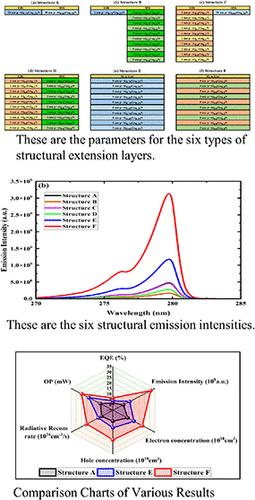高铝含量跨超晶格p型区实现无电子阻挡层的高效深紫外发光二极管
IF 8.2
2区 材料科学
Q1 MATERIALS SCIENCE, MULTIDISCIPLINARY
引用次数: 0
摘要
深紫外发光二极管(duv - led)面临着空穴注入不良和电子泄漏严重等严峻挑战,严重限制了其外部量子效率(EQE)。本研究利用集成Schrödinger-Poisson和漂移扩散模型的SiLENSe模块,拥有并模拟了六个具有不同铝成分的p型超晶格的DUV-LED结构。其中,结构F消除了传统的电子阻挡层(EBL),采用了分级的Al0.8Ga0.2N/Al0.6Ga0.4N超晶格,性能最好。EQE为6.3%,峰值光输出功率为25 mW。详细的能带图和载流子分布分析证实,该结构在增强空穴注入的同时,有效地抑制了电子泄漏。这些改进归因于阶梯式价带谱的形成和超晶格内电子势垒的增强。这种双功能设计突出了通过p型波段工程推进高性能duv - led的可行和高效策略,而无需依赖传统的ebl。本文章由计算机程序翻译,如有差异,请以英文原文为准。

High-Efficiency Deep Ultraviolet Light-Emitting Diodes without an Electron Blocking Layer Enabled by a High-Aluminum-Content Spanning Superlattice p-Type Region
Deep ultraviolet light-emitting diodes (DUV-LEDs) face critical challenges such as poor hole injection and significant electron leakage, both of which severely limit their external quantum efficiency (EQE). This study possesses and simulates six DUV-LED structures featuring p-type superlattices with varying aluminum compositions using the SiLENSe module that integrates Schrödinger-Poisson and drift-diffusion models. Among them, structure F, which eliminates the conventional electron blocking layer (EBL) and incorporates a graded Al0.8Ga0.2N/Al0.6Ga0.4N superlattice, demonstrates the best performance. It achieves an EQE of 6.3% and a peak optical output power of 25 mW. Detailed analyses of band diagrams and carrier distributions confirm that the structure simultaneously enhances hole injection and effectively suppresses electron leakage. These improvements are attributed to the formation of stepped valence band profiles and reinforced electron barriers within the superlattice. This dual-function design highlights a viable and efficient strategy for advancing high-performance DUV-LEDs through p-type band engineering without relying on traditional EBLs.
求助全文
通过发布文献求助,成功后即可免费获取论文全文。
去求助
来源期刊

ACS Applied Materials & Interfaces
工程技术-材料科学:综合
CiteScore
16.00
自引率
6.30%
发文量
4978
审稿时长
1.8 months
期刊介绍:
ACS Applied Materials & Interfaces is a leading interdisciplinary journal that brings together chemists, engineers, physicists, and biologists to explore the development and utilization of newly-discovered materials and interfacial processes for specific applications. Our journal has experienced remarkable growth since its establishment in 2009, both in terms of the number of articles published and the impact of the research showcased. We are proud to foster a truly global community, with the majority of published articles originating from outside the United States, reflecting the rapid growth of applied research worldwide.
 求助内容:
求助内容: 应助结果提醒方式:
应助结果提醒方式:


